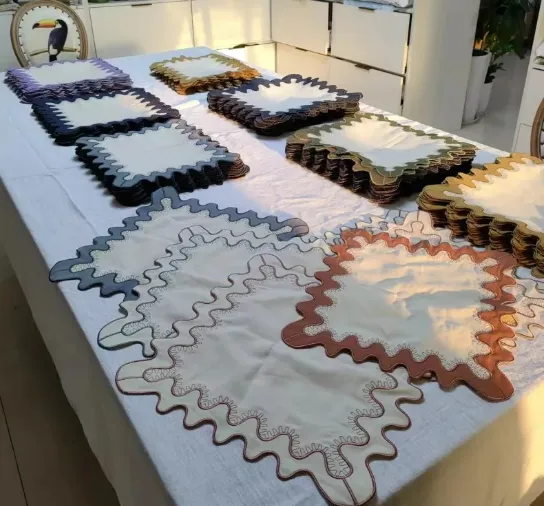Organic Cotton Fabric: The combination of sustainability and quality
May . 15, 2025 11:15 Back to list
Organic Cotton Fabric: The combination of sustainability and quality
Organic Cotton Fabric, as an emerging textile material, is increasingly favored by consumers and producers. It is not just a choice of fabric, but also a practice of the concept of sustainable development. This article will explore the definition, characteristics, advantages, position, and prospects of Organic Cotton Fabric in the textile industry.

Organic Cotton Fabric, As the name suggests, it refers to cotton that fully complies with organic agriculture standards during the production process
This means that during the planting process, the use of chemically synthesized pesticides, fertilizers, herbicides, etc. is prohibited, and environmentally friendly methods such as biological control, crop rotation, and organic composting are adopted instead. This planting method aims to maintain soil health, protect biodiversity, and reduce environmental pollution. The fabric woven from this cotton is called cotton fabric.
Organic Cotton Fabric has many advantages compared to traditional cotton fabrics
Firstly, cotton fabric by the yard is more environmentally friendly. Avoiding the use of chemical substances significantly reduces pollution to water, soil, and air, thus benefiting the health of the ecosystem. Secondly, Organic Cotton Fabric is safer. There are fewer residual chemicals, reducing irritation and potential allergic reactions to human skin, making it particularly suitable for infants, young children, and people with sensitive skin. Furthermore, the fibers of Organic Cotton Fabric are usually more complete, resulting in softer and more breathable fabrics with better moisture absorption and comfort.
Organic Cotton Fabric also faces some challenges
Its production cost is relatively high due to the longer planting cycle of organic agriculture, which usually results in lower yields than traditional cotton. In addition, the certification system for cotton cloth is also quite complex and requires strict audits by third-party organizations to ensure that its production process complies with organic standards.
However, with the increasing awareness of environmental protection among consumers and the pursuit of a healthy lifestyle, the pure cotton fabric market is showing a thriving development trend. More and more clothing brands are adopting Organic Cotton Fabric fabric and launching environmentally friendly products. The government is also actively promoting the development of organic agriculture and introducing relevant policies to support the production and sales of Organic Cotton Fabric.
In short, Organic Cotton Fabric is a textile material that balances sustainability and quality. It reduces environmental pollution, safeguards consumer health, and provides a more comfortable wearing experience by following organic agriculture standards. Despite facing challenges in terms of cost and certification, Organic Cotton Fabric is expected to play an increasingly important role in the textile industry as market demand grows and technology advances, leading the textile industry towards a more environmentally friendly and sustainable direction.
Organic Cotton Fabric FAQs
What is Organic Cotton Fabric?
Organic Cotton Fabric refers to cotton that does not use synthetic pesticides, fertilizers, or genetically modified seeds during the planting process and meets organic agriculture standards. The processing also avoids the use of harmful chemicals such as chlorine bleach and heavy metal dyes, ensuring greater safety for the environment and human health.
What is the difference between Organic Cotton Fabric and regular cotton?
Planting method: Organic Cotton Fabric adopts natural cultivation (such as crop rotation and biological pest control), while ordinary cotton relies on pesticides and fertilizers.
Environmental friendliness: Organic Cotton Fabric reduces water pollution and soil degradation, and ordinary cotton cultivation accounts for 16% of global pesticide use.
Touch: Organic Cotton Fabric fibers are softer (as they have not been chemically damaged) and suitable for sensitive skin.
Certification: Organic Cotton Fabric must be certified by GOTS (Global Organic Textile Standard) or OCS (Organic Content Standard).
What products is Organic Cotton Fabric suitable for?
Baby products: diapers, jumpsuits (hypoallergenic).
Close fitting clothing: underwear, T-shirts, pajamas (breathable and skin friendly).
Home textiles: bed sheets, towels, blankets (durable and not easily irritating to the skin).
Environmentally friendly fashion: Sustainable brands often use Organic Cotton Fabric to make jeans, hoodies, etc.
What are the drawbacks of Organic Cotton Fabric?
High price: Due to lower production and higher certification costs, it is 20% to 50% more expensive than ordinary cotton.
Poor wrinkle resistance: Like regular cotton, it is prone to wrinkling and requires ironing or natural wrinkling sensation.
Color fastness limitations: Some organic dyes have fewer color choices and may fade faster.
How to identify the real Organic Cotton Fabric?
Check the certification label: such as GOTS (requiring at least 95% organic fiber) OCS。
Touch and odor: High quality Organic Cotton Fabric is soft and free of chemical odors, while regular cotton may have residual bleach odors.
Brand transparency: Reliable brands will publicly disclose their supply chain and certification information (such as Patagonia, PACT).
-
Wholesale Custom Pure Linen Womens Halter Top Shirts&Pajamas
NewsNov.17,2025
-
Indian Block Print Napkins | Factory Direct OEM/ODM
NewsNov.17,2025
-
Printed Cloth Napkin – Custom Designs, Bulk & Wedding Ready
NewsNov.10,2025
-
Indian Block Print Napkins – Handmade, Wholesale, OEM/ODM
NewsNov.10,2025
-
OEKO Bamboo Bedding Set: Cooling, Hypoallergenic Comfort
NewsNov.10,2025
-
Indian Block Print Napkins – Handcrafted Linen, Wholesale
NewsNov.10,2025
